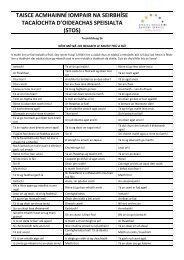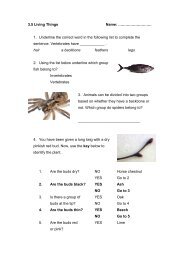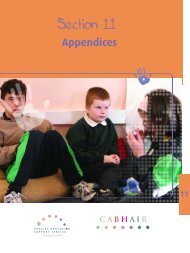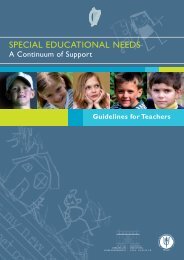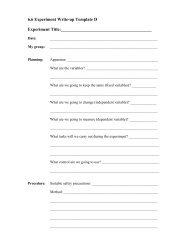1 Literacy Challenges and Strategies for the Deaf Student ...
1 Literacy Challenges and Strategies for the Deaf Student ...
1 Literacy Challenges and Strategies for the Deaf Student ...
- No tags were found...
You also want an ePaper? Increase the reach of your titles
YUMPU automatically turns print PDFs into web optimized ePapers that Google loves.
<strong>Challenges</strong> <strong>and</strong> <strong>Strategies</strong> H<strong>and</strong>outReading<strong>Literacy</strong> <strong>Challenges</strong> <strong>and</strong> <strong>Strategies</strong> <strong>for</strong> <strong>the</strong> <strong>Deaf</strong> <strong>Student</strong>Difficulty reading <strong>the</strong> questions/ text Check <strong>the</strong> readability of <strong>the</strong> text. Highlight difficult words. These words can be written on <strong>the</strong> board/flashcards <strong>and</strong> taught explicitly. Graphic <strong>and</strong> picture cues can assist comprehension <strong>and</strong> aid word prediction. Pupils to scan <strong>the</strong> problem <strong>for</strong> unknownwords. Highlight <strong>and</strong> discuss <strong>and</strong> define with teacher/peer. Reading pen. Reading buddy.Comprehension difficulties Word walls. Teach <strong>the</strong> pupil to find key words that give <strong>the</strong> clue to <strong>the</strong> meaning. Encourage <strong>the</strong> pupil to draw a simple sketch of word problems, turn <strong>the</strong> problem into pictures not words. Highlight nouns/ verbs in one colour, vocabulary in ano<strong>the</strong>r etc. Encourage repeated reading. Allow <strong>the</strong> pupil to use aruler/reading ruler if <strong>the</strong> pupil loses <strong>the</strong>ir place. If <strong>the</strong> teacher is reading <strong>the</strong> questions/giving instructions/explaining concepts be aware of <strong>the</strong> speed used, importantto be at a pace that allows pupils to process <strong>the</strong> in<strong>for</strong>mation. Teachers preview <strong>the</strong> story/ passage <strong>and</strong> summarises content <strong>and</strong> main points with Mindmaps.Word comprehension Tactile demonstrations <strong>and</strong> activities Use pictures/ video/ o<strong>the</strong>r media to rein<strong>for</strong>ce <strong>and</strong> review vocabulary taught. (Google images) High light multiple word meanings- especially in subject specific contexts, e.g many meaning of <strong>the</strong> word note Use all sources available- computer/ tv/ video Cloze tests, blank every nth word to have r<strong>and</strong>om mix of structural <strong>and</strong> lexical words Materials without words- comic’s picture stories too be completed RAP- read <strong>the</strong> text, ask yourself what does it mean, put <strong>the</strong> text into own wordsNew vocabulary <strong>Student</strong>s may need to be taught- word meanings/ syntax/ figurative language/ idioms/ inferences Word web. Similar to mind maps, link as many words to one in <strong>the</strong> centre, e.g ice-cream-cold-hard/ soft- chocolatecone.... Use all sources available- computer/ tv/ video Highlight difficult words. These words can be written on <strong>the</strong> board/flashcards <strong>and</strong> taught explicitly. Graphic <strong>and</strong> picture cues can assist comprehension <strong>and</strong> aid word prediction. Pupils to scan <strong>the</strong> problem <strong>for</strong> unknownwords. Highlight <strong>and</strong> discuss <strong>and</strong> define with teacher/peer.1
Finding/ Using required in<strong>for</strong>mationTeaching Left to right directional words Pupils may need a personal strategy <strong>for</strong> remembering this, some ideas may be to mark left <strong>and</strong> right on <strong>the</strong>corners of <strong>the</strong>ir desk show that <strong>the</strong>ir left h<strong>and</strong> can make <strong>the</strong> letter L by holding <strong>the</strong> left fingers toge<strong>the</strong>r <strong>and</strong> <strong>the</strong>thumb horizontal.Incorporate <strong>the</strong> teaching of left to right in all day-to day activities.If <strong>the</strong> pupil has difficulties knowing where to begin on <strong>the</strong>ir copy <strong>the</strong> teacher may mark a point in marker where<strong>the</strong>y can beginPrepositions ( above, below) Play games that incorporate <strong>the</strong>se words in PE <strong>for</strong> example cross curricular rein<strong>for</strong>cement needed at PP level Cue cardsDifficult directional words e.g. horizontal, vertical,diagonalUse PE/ o<strong>the</strong>r subjects as a way to introduce <strong>the</strong>se words.Use concrete objects <strong>and</strong> allow pupils to arrange <strong>the</strong>m horizontally/ diagonally etc, Maps can work really wellhereDifficulties reading questions/ structuring answers Colour code headings etc Use squared paper or lined paper turned sideways to create columns Start work with title/ date Colour code answers Underline key requirement of question (who, what, where, how) St<strong>and</strong>ardise question <strong>for</strong>mats where possible across subjects Teach explicitly exam vocabulary (illustrate with aid of a diagram= draw a picture)Copying from blackboard Use different coloured chalk to assist <strong>the</strong> child in following from one line to ano<strong>the</strong>r Reduce amount of in<strong>for</strong>mation to be copied Provide copy of in<strong>for</strong>mation3
OrganisationLocating books/equipment difficulties Colour code books <strong>and</strong> copies. Have a separate pencil case <strong>for</strong> maths to include ruler, pencil, protractor etc. Have a folder (as distinct as possible) <strong>for</strong> each subjects h<strong>and</strong>outs, loose leaf pages etc. Consider a home school -wallet <strong>for</strong> home/school work E-mailing of homework where possible to encourage computer literacy, use of spell check etcWriting, organisation / where to begin on <strong>the</strong> page Clear margin, page / work title Teach pupils to underline key words in answer. Organisational Check list / Task Management Board Class prizes <strong>for</strong> most improved copy/ neatest work of <strong>the</strong> week Ensure correct use of pens/ pencils Avoid fountain pensWriting down homework Consider a buddy system/Allow time specifically <strong>for</strong> this to be taken down at <strong>the</strong> end of <strong>the</strong> maths lesson. Consider <strong>the</strong> use of colour-coded homework sheetsCopying from blackboard Use different coloured chalk to assist <strong>the</strong> child in following from one line to ano<strong>the</strong>r Reduce amount of <strong>for</strong>mation to be copied Allow <strong>the</strong> student to have a copy of in<strong>for</strong>mation from a peer Use of ‘white boards’ <strong>and</strong> technology means many notes can be mailed to <strong>the</strong> class Get students to complete ‘cloze- tests’ based on <strong>the</strong> blackboard notes4
LanguageLanguage fluency difficulty Awareness of key areas of difficulty – use of definite <strong>and</strong> indefinite article ‘<strong>the</strong>’ & ‘a’ Teach, teach <strong>and</strong> teach again <strong>the</strong> use of ‘s’ Self talk, pupil to read aloud as <strong>the</strong>y work so <strong>the</strong>y can hear <strong>the</strong> language <strong>and</strong> method that <strong>the</strong>y are using,teacher should model this method. (only in a supportive class environment) Chunk <strong>the</strong> in<strong>for</strong>mation – speak in short, clear sentences Allow ‘thinking time’ <strong>and</strong> ‘response time’ Use mindmaps to outline <strong>the</strong> lesson, to teach <strong>and</strong> to summarise Encourage pupils to create personal mindmaps to clarify <strong>the</strong> lesson <strong>for</strong> <strong>the</strong>mselves <strong>and</strong> to facilitateprocessing of in<strong>for</strong>mation Support ‘teacher talk’ with visual cues Provide concrete materials <strong>and</strong> resourcesVocabulary Use accessible language appropriate to students comprehension Introduce new vocabulary in a concrete way e.g Wave (verb) also has a different meaning in science/geography (use of multi-media/ internet invaluable) Visual Cues Pre-teach <strong>the</strong> key subject/ class vocabulary- key word list on <strong>the</strong> board Access <strong>and</strong> proper use of Dictionary, basic picture one may be most accessible <strong>for</strong> a time Online Dictionary/ word games Verbal instructions to be accompanied by visuals <strong>and</strong>/ or practical demonstration Use word games/ build alphabet knowledge Easier to teach words with primary lexical meaning-verbs, nouns, adjectives etc., than structure/ functionwords- prepositions etc Teaching of multiple meanings use of pictures Demonstrate structure words- on/ in/ who Use of story maps/ illustration to assess students underst<strong>and</strong>ing of literature Dictation of or writing of students own stories- language experience method- keep a diary/ journal Dialogue journals, each student starts a dialogue <strong>and</strong> ano<strong>the</strong>r continues5
AttentionAvoiding student frustration Break tasks into a series of small steps Give in<strong>for</strong>mation in more than one modality Keep instructions short – CHUNK Demonstrate instructions with diagram or picture Provide students with a scribble pad Allow thinking time – revision picture / mind map Checklists / Adhesive notes Seat students close to where teacher usually st<strong>and</strong>s Transparent zip wallet/folder – urgent tasks Teacher should face student, <strong>and</strong> windows should be located at rear of class Ensure appropriate use of hearing aids Utilise technological aids where possible <strong>and</strong> practicable FM systems/ sound field systems etc Check <strong>the</strong> seating position of <strong>the</strong> student away from sources of noise (projectors/ open doors/ computersetc) Ensure <strong>the</strong> student knows what is happening Teach communication strategies to express anger/ frustration-(Tucker Turtle seris)Social skills/ well being (a ‘happy’ secure student ismore likely to improve academically, when <strong>the</strong>y feel<strong>the</strong>y are amongst a supportive peer group)Board games <strong>and</strong> computers may e utilised <strong>for</strong> turn-taking, communication <strong>and</strong> social interactionUtilise friendship building tasks- buddy system etcMay require direct teaching if social skills/ languageBe aware of difficulties <strong>for</strong> students in less structured times of <strong>the</strong> school day- play/ yard timeDirectly teach organisational skillsCo operative learning can assist underst<strong>and</strong>ing of materialsSign language classes <strong>for</strong> <strong>the</strong> class where appropriateEnsure student is aware of who is speaking at a given time6
Practicalities <strong>for</strong> <strong>the</strong> teacherAllow adequate time <strong>for</strong> <strong>the</strong> student to process <strong>and</strong> respondWork closely with speech <strong>and</strong> language <strong>the</strong>rapist/ family/ principal carer to establish primary means ofcommunicationProvide clear <strong>and</strong> unambiguous instruction with regard to home/ class work <strong>and</strong> expectations.Be consistent with language, where possible pre-teach new vocabularyPlace emphasis on key words/ instructions/ concepts. (Underline/ colour coded as well as in speech etc)Pace oral instructionsUse of all media should have subtitlesSupply photocopied h<strong>and</strong>outs ra<strong>the</strong>r than lots of dictationAvoid over pronunciationAvoid beards/ over obtrusive glasses etcAwareness of audiological reports to ensure comprehensive use of all available hearingAsk student ‘what do <strong>the</strong>y think?’ encourage longer responsesTeach an underst<strong>and</strong>ing of words through use of actual objects where possible <strong>and</strong> move concrete to abstractCheck underst<strong>and</strong>ingWrite <strong>the</strong> title of new work on <strong>the</strong> board to prepare <strong>the</strong> studentEncourage questioning/ advocacy <strong>and</strong> perhaps develop cues <strong>for</strong> ‘I do not underst<strong>and</strong>’Surround students in literacy environmentEncourage a positive sense of reading within <strong>the</strong> school- JCSP programmes/ reading week/ use of libraries/ReadathonGuided homework- clear, understood <strong>and</strong> home involvement ideallyUse a consistent system of marks <strong>for</strong> correcting (cross curricular if possible at PP)Focus on one aspect of literacy to correct at a time- school ‘comma’ week/ language boardsUseful internet resources www.jcspliteracy.ie www.primaryresources.co.uk/english www.literacyplanet.com www.worksheetgenius.com www.bbc.co.uk/schools www.readingrockets.org www.sess.ie www.irishdeafkids.ie www.deafhear.ie www.education.ox.ac.uk/ndcs7


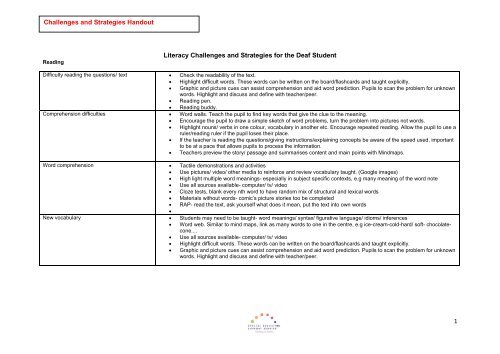

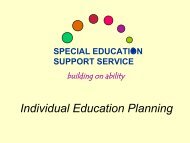
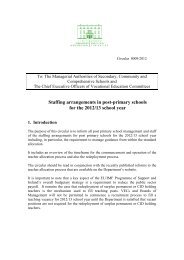

![to download [PDF, 98KB]](https://img.yumpu.com/50090201/1/184x260/to-download-pdf-98kb.jpg?quality=85)


